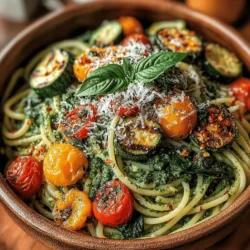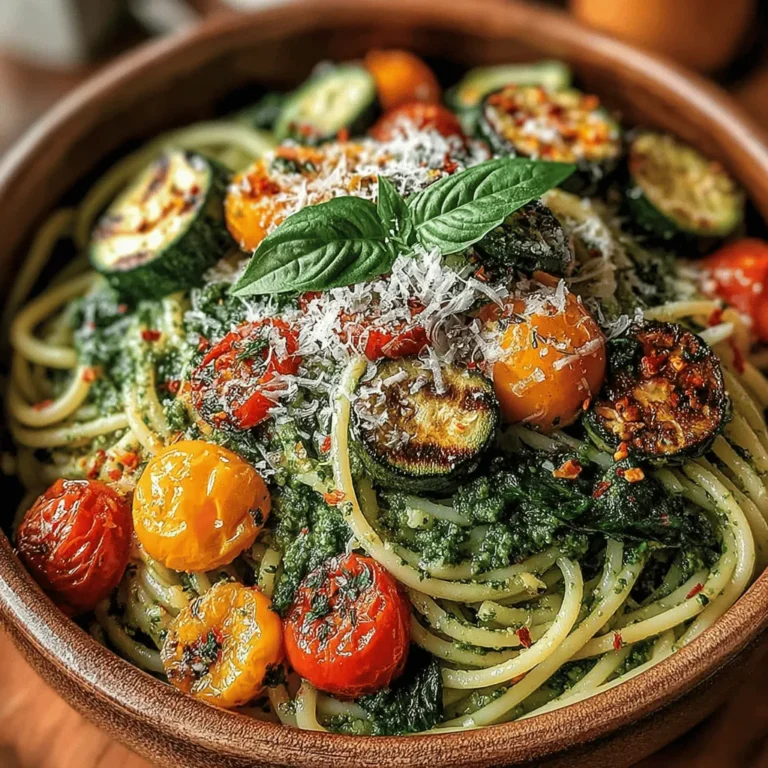Summer Veggie Pesto Pasta Recipe
As the warm sun brightens our days and the lush gardens begin to overflow with colorful produce, summer becomes the perfect season for light and vibrant cooking. The joys of summer cooking lie not only in the abundance of fresh ingredients but also in the simplicity of preparing meals that celebrate these flavors. One dish that embodies the essence of summer is the Summer Veggie Pesto Pasta. This delightful recipe features a medley of seasonal vegetables and a homemade pesto that brings a burst of flavor and nourishment to your table.
The Appeal of Summer Veggie Pesto Pasta
Summer Veggie Pesto Pasta is a dish that is as appealing to the eye as it is to the palate. It combines al dente pasta with a rainbow of fresh, seasonal vegetables, all tossed in a vibrant homemade pesto. The beauty of this dish lies in its versatility; it can be served warm or cold, making it an excellent choice for picnics, potlucks, or a light dinner on a warm evening. The freshness of the ingredients not only enhances the flavor but also provides a nutritious meal that can be enjoyed guilt-free.
Understanding Pesto
To truly appreciate Summer Veggie Pesto Pasta, it’s essential to understand the foundation of its flavor: pesto. This traditional Italian sauce hails from Genoa, where it was originally made by crushing fresh basil leaves, garlic, pine nuts, Parmesan cheese, and olive oil together. The resulting paste is aromatic and rich, serving as a perfect complement to pasta, sandwiches, and even grilled meats.
One of the many benefits of making pesto at home is the ability to control the ingredients and customize the flavors. While traditional pesto features pine nuts, you can easily swap in other nuts, such as walnuts or almonds, to create different flavor profiles. Additionally, experimenting with various herbs—like arugula or parsley—can lead to exciting twists on the classic recipe. For those with dietary restrictions, using dairy-free cheese or omitting cheese altogether can still yield a delicious pesto.
Ingredients Breakdown
The success of Summer Veggie Pesto Pasta relies heavily on the quality of its ingredients. Here’s a closer look at the main components that make this dish a standout:
– Pasta: Choose your favorite type, whether it’s spaghetti, penne, or gluten-free options, ensuring it cooks to an al dente consistency for the best texture.
– Fresh Basil: The star of the pesto, fresh basil adds a fragrant aroma and vibrant green color. Look for bright, unblemished leaves for optimal flavor.
– Seasonal Vegetables: This dish shines when you incorporate a variety of seasonal vegetables such as zucchini, bell peppers, cherry tomatoes, and asparagus. These not only enhance the flavor but also add essential nutrients.
– Pine Nuts: Often used in traditional pesto, pine nuts contribute creaminess and a subtle nutty flavor. Toasting them lightly can intensify their taste.
– Parmesan Cheese: This adds a salty, umami punch to the pesto. For a dairy-free option, nutritional yeast can be a great substitute.
– Olive Oil: A high-quality extra virgin olive oil elevates the dish, providing healthy fats and a rich flavor.
– Garlic and Lemon Juice: Essential for balancing flavors, garlic adds a spicy kick, while lemon juice brightens the dish and enhances the freshness of the vegetables.
With these ingredients in hand, you can create a vibrant and nutritious dish that celebrates the best of summer produce. Each component not only brings its own unique flavor but also offers various nutritional benefits, making this pasta a wholesome option for any meal.
Step-by-Step Cooking Instructions
Now that you’re familiar with the ingredients, it’s time to dive into the cooking process. Preparing Summer Veggie Pesto Pasta is a straightforward endeavor that allows you to enjoy the process as much as the final dish.
1. Cook the Pasta: Start by bringing a large pot of salted water to a boil. Once boiling, add your pasta of choice. For the best texture, aim for al dente pasta, which should be firm to the bite. Be sure to check the cooking time on the package and taste a piece a minute or two before the time is up to ensure it doesn’t overcook.
2. Reserve Pasta Water: As the pasta cooks, remember to reserve about a cup of the pasta cooking water before draining. This starchy water can be used later to adjust the consistency of your pesto and help it cling to the pasta.
3. Prepare the Vegetables: While the pasta is cooking, wash and chop your selection of seasonal vegetables into bite-sized pieces. Lightly sauté them in a pan with a drizzle of olive oil until they are tender but still vibrant. This step enhances their natural flavors without losing their crunch.
4. Craft the Perfect Pesto: In a food processor, combine the fresh basil leaves, toasted pine nuts, garlic, and Parmesan cheese. Pulse until the ingredients are finely chopped. Then, with the processor running, slowly drizzle in the olive oil until the mixture is smooth and emulsified. If the pesto is too thick, add a bit of the reserved pasta water until you reach your desired consistency.
5. Balance the Flavors: Taste the pesto and season with salt, pepper, and a squeeze of fresh lemon juice. This balancing step is crucial, as it elevates the flavors and brings brightness to the dish.
6. Combine: Once the pasta is cooked and drained (don’t forget to reserve that water!), return it to the pot over low heat. Add the sautéed vegetables and the homemade pesto. Stir gently, incorporating all ingredients. If the mixture feels dry, gradually add some of the reserved pasta water until everything is well-coated and luscious.
Following these steps will help you create a Summer Veggie Pesto Pasta that embodies the flavors of the season, showcasing fresh ingredients and a vibrant pesto that is sure to delight your taste buds.
In the next section of this article, we will explore additional variations, serving suggestions, and tips for making this dish even more enjoyable. Stay tuned for more insights into creating the perfect summer meal!
{{image_2}}
Sautéing the Vegetables
Sautéing vegetables is a critical step in making your Summer Veggie Pesto Pasta truly exceptional. Start by heating a couple of tablespoons of olive oil in a large skillet over medium heat. Once the oil shimmers, add your chopped vegetables. Ideal choices include bell peppers, zucchini, cherry tomatoes, and asparagus, all of which complement the flavors of the pesto beautifully.
Cooking Times for Different Vegetables
Understanding the cooking times for various vegetables is essential to achieving perfectly sautéed results. Here’s a quick guide:
– Zucchini: Sauté for about 3-4 minutes until tender but still slightly crisp.
– Bell Peppers: These take around 5-6 minutes, allowing them to soften and develop a sweet flavor.
– Cherry Tomatoes: Just 2-3 minutes is enough for them to burst and release their juices.
– Asparagus: Cook for about 4-5 minutes until they are bright green and tender yet firm.
Sautéing not only cooks the vegetables but also concentrates their flavors. As they caramelize, they develop a rich, sweet taste that enhances the overall dish.
How Sautéing Enhances Flavors and Textures
The technique of sautéing brings out the natural flavors of vegetables while adding a delightful texture. The quick cooking method allows the vegetables to retain their vibrant colors and nutrients while also creating a slightly crispy exterior. This contrast between the tender pasta and the sautéed vegetables adds depth to your dish, making every bite an enjoyable experience.
Combining Pasta, Pesto, and Vegetables
Once your pasta is cooked al dente and your vegetables are sautéed to perfection, it’s time to bring everything together. In a large mixing bowl, combine the drained pasta with the sautéed vegetables.
Techniques for Ensuring Even Distribution of Pesto
To achieve an even coating of pesto, start by adding a few spoonfuls to the pasta and vegetables. Use a pair of tongs or a large spatula to gently toss the mixture. This method ensures that every element gets a good amount of dressing. If you find that the pesto is too thick and not coating the pasta well, feel free to add a splash of the reserved pasta cooking water.
Adjusting Consistency Using Reserved Pasta Water
The key to a creamy and cohesive dish lies in the reserved pasta water. This starchy water helps emulsify the pesto, creating a luscious sauce that clings to the pasta and enhances the flavor. Start with a quarter cup of reserved water and gradually add more as needed until you reach your desired consistency.
Serving Suggestions
Now that your Summer Veggie Pesto Pasta is beautifully combined, it’s time to think about how to serve it.
Creative Ways to Present the Dish
Presentation plays a vital role in the dining experience. Consider serving the pasta in large, shallow bowls to showcase the vibrant colors of the vegetables. A sprinkle of freshly grated Parmesan cheese or a drizzle of extra virgin olive oil right before serving can elevate the dish’s look and flavor. Adding a few whole basil leaves on top can also enhance visual appeal.
Suggestions for Pairing with Complementary Dishes or Sides
For a balanced meal, pair your pasta with a light salad dressed with a lemon vinaigrette. A side of garlic bread or crusty artisan bread complements the flavors beautifully, allowing for a delightful contrast in textures. If you’re feeling adventurous, consider serving it alongside grilled chicken or shrimp for added protein.
Importance of Garnishing for Visual Appeal
Garnishing is essential not just for aesthetics but also for flavor. Finishing your dish with a sprinkle of toasted pine nuts or walnuts can add a satisfying crunch, while fresh herbs like parsley or basil can enhance the dish’s fragrance. A squeeze of lemon juice right before serving adds brightness, making the dish even more refreshing.
Nutritional Information
This Summer Veggie Pesto Pasta is not only delicious but also packed with health benefits.
Overview of the Dish’s Health Benefits
The vegetables provide essential vitamins and minerals, while the whole grain pasta offers dietary fiber, which is crucial for digestive health. Pesto, made from fresh basil, nuts, and olive oil, contains healthy fats and antioxidants that contribute to overall well-being.
Breakdown of Calories and Nutrients per Serving
A typical serving (around 1.5 cups) of this dish contains approximately 400-450 calories, depending on the amount of pesto and cheese used. It generally provides:
– Carbohydrates: 60g
– Protein: 12g
– Fat: 15g
– Fiber: 5g
This nutritional profile makes it a balanced meal option that satisfies hunger without compromising health.
Importance of Incorporating Vegetables in Daily Meals
Incorporating a variety of vegetables into your meals is vital for maintaining a balanced diet. They provide essential nutrients, antioxidants, and fiber while being low in calories. This Summer Veggie Pesto Pasta is an excellent way to meet your daily vegetable intake in a delicious and enjoyable manner.
Seasonal Variations
One of the great things about this recipe is its versatility. You can easily adapt it to suit different seasons and the availability of fresh produce.
Ideas for Adapting the Recipe for Different Seasons
In the spring, consider adding fresh peas or asparagus, while in the fall, roasted butternut squash and kale can create a hearty variation. In winter, you might choose root vegetables like carrots and parsnips, which can be caramelized for added flavor.
Suggestions for Alternative Vegetables Based on Availability
Feel free to experiment with the vegetables according to what is in season or what you have on hand. Broccoli, spinach, or even eggplant can make excellent additions or substitutes.
How to Adjust Flavors to Fit Seasonal Produce
When using seasonal produce, you might find that adjusting the flavors of your pesto can enhance the overall dish. For example, adding a hint of lemon zest in spring or a dash of nutmeg in fall can elevate the flavor profile of your pasta.
Conclusion
Making Summer Veggie Pesto Pasta is not just about following a recipe; it’s about embracing the joy of cooking with fresh, seasonal ingredients. The process of sautéing vegetables, combining them with perfectly cooked pasta and vibrant pesto, culminates in a dish that is both satisfying and nourishing.
As you prepare this dish, don’t hesitate to experiment with different vegetables, flavors, and presentation styles. Cooking is an art, and each meal presents an opportunity to express your creativity. So gather your loved ones, share this delightful dish, and savor the experience of eating together. The joy of cooking and sharing meals is what makes food truly special, and with Summer Veggie Pesto Pasta, you’re on your way to creating memorable moments around the table.


